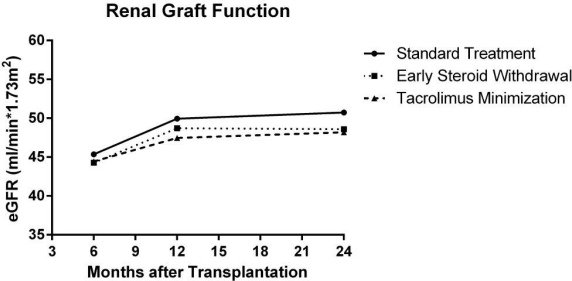Early Steroid Withdrawal or Tacrolimus Minimization versus Standard Immunosuppression in Renal Transplant Recipients: The Allegro Trial
1Nephrology, UMCG, Groningen, Netherlands
2Nephrology, AMC, Amsterdam, Netherlands
3Nephrology, LUMC, Leiden, Netherlands.
Meeting: 2018 American Transplant Congress
Abstract number: C71
Keywords: Immunosuppression, Kidney transplantation
Session Information
Session Name: Poster Session C: Kidney Immunosuppression: Novel Regimens and Drug Minimization
Session Type: Poster Session
Date: Monday, June 4, 2018
Session Time: 6:00pm-7:00pm
 Presentation Time: 6:00pm-7:00pm
Presentation Time: 6:00pm-7:00pm
Location: Hall 4EF
Background
Current immunosuppressive regimen in most renal transplant recipients (RTR) combines basiliximab induction with tacrolimus, mycophenolic acid and prednisolone maintenance therapy. Reduction of immunosuppression by withdrawal of steroids or tacrolimus minimization could be beneficial. The ALLEGRO trial evaluated safety and efficacy of early steroid withdrawal or tacrolimus minimization 6 months after transplantation.
Methods
In this multicenter, open-label RCT, 298 RTR of a living, DBD or DCD kidney donor (low to intermediate immunological risk) were randomized to receive either 1) standard maintenance treatment with prednisolone, mycophenolic acid and tacrolimus once daily (target trough from 6 months 6-10 ng/ml), 2) steroid withdrawal in the first week after renal transplantation, or 3) tacrolimus minimization from 6 months onwards (target trough 3-5 ng/ml). All RTR received induction therapy with basiliximab. The primary end point was renal function as measured by eGFR (CKD-EPI) at 6, 12 and 24 months in an intention to treat analysis. Secondary end points included biopsy proven acute rejection (BPAR), patient and graft survival.
Results
At baseline, patient characteristics did not differ between the 3 groups. Tacrolimus trough levels were within target ranges at all-time points. There were no significant differences in eGFR between the groups at 6 months (p=0.90), 12 months (p=0.69) or 24 months (p=0.71) after transplantation.  During follow-up, 49 (16.4%) RTR had BPAR, 10 (3.4%) RTR developed graft failure and 11 (3.7%) RTR died. There was no difference in BPAR-free survival (p = 0.75), graft- (log-rank p=0.46) or patient survival (log-rank p=0.73) between the 3 groups.
During follow-up, 49 (16.4%) RTR had BPAR, 10 (3.4%) RTR developed graft failure and 11 (3.7%) RTR died. There was no difference in BPAR-free survival (p = 0.75), graft- (log-rank p=0.46) or patient survival (log-rank p=0.73) between the 3 groups.
Conclusion
Early steroid withdrawal after transplantation or tacrolimus minimization from 6 months onwards are efficacious alternatives compared to standard quadruple immunosuppressive therapy. However, tacrolimus minimization from 6 months onwards did not result in improvement of renal function.
CITATION INFORMATION: Sanders J., Gomes-Neto A., v Dijk M., v Sandwijk M., de Fijter H., Homan vd Heide J., de Vries A., Bemelman F. Early Steroid Withdrawal or Tacrolimus Minimization versus Standard Immunosuppression in Renal Transplant Recipients: The Allegro Trial Am J Transplant. 2017;17 (suppl 3).
To cite this abstract in AMA style:
Sanders J, Gomes-Neto A, Dijk Mv, Sandwijk Mv, Fijter Hde, Heide JHomanvd, Vries Ade, Bemelman F. Early Steroid Withdrawal or Tacrolimus Minimization versus Standard Immunosuppression in Renal Transplant Recipients: The Allegro Trial [abstract]. https://atcmeetingabstracts.com/abstract/early-steroid-withdrawal-or-tacrolimus-minimization-versus-standard-immunosuppression-in-renal-transplant-recipients-the-allegro-trial/. Accessed December 19, 2025.« Back to 2018 American Transplant Congress
